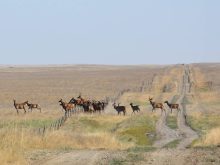In Part 5 of our spring primer series, Western Producer reporters Sean Pratt and Karen Morrison find farmers in an optimistic mood in northwestern and west-central Saskatchewan.
Despite heavy snow cover last winter, the fields have dried up and seeding conditions are favourable.
DELMAS, Sask. – Farmers near North Battleford, Sask., are heading into summer with a spring in their step.
“I would say there is more optimism this year than there has been in a lot of years. The prices of grains are coming up a bit and we’re hoping that will continue to hold,” Rick Kehler said during a break from seeding a field of Striker green peas near Delmas, Sask.
Read Also

Bunge’s crop mix is changing
Bunge has predominantly been a soybean processing firm, but that’s about to change after the merger with Viterra with softseed processing and grain merchandising gaining ground.
Kehler, who works for Lorne Ferguson, said the farm is coming off a terrific 2006 and heading into 2007 with superb soil moisture conditions. Seeding is a week ahead of normal with 1,500 of Ferguson’s 2,700 acres in the ground as of May 16.
Growers are expected to wrap up seeding this week, said Scott Anderson, manager of agronomic services at Saskatchewan Wheat Pool’s elevator in North Battleford.
Potholes and sloughs have excess moisture but for the most part the windy spring has dried up surface moisture sufficiently to allow farmers to go about their business.
“With the amount of snow we had, we thought we would have had a lot more moisture, but things have dried up nicely and guys are able to get to the majority of their fields,” Anderson said.
He agreed with Kehler that there is plenty of optimism heading into summer with good subsoil moisture reserves and strong grain prices across the board.
“I’m really happy with how things are unfolding.”
Canola, barley and pea plantings are expected to be up in North Battleford. For the most part that jibes with Statistics Canada’s March seeding intentions report, except in the case of pea acreage, which was forecast to remain static.
Anderson said the interest in peas comes from a desire to cut back on soaring input costs. Peas are a nitrogen-fixing crop that growers can lock in at $6 per bushel.
“When you can pull off a 30 to 40 bu. crop fairly regularly around here it starts to pay,” he said.
Kehler is seeding 300 acres of peas for Ferguson this year. Ferguson realizes extra input savings with the crop because he doesn’t use phosphate with his peas.
“Cutting your fertilizers out takes you down about $30 per acre right there,” Kehler said.
Ferguson is sticking with green peas, a crop he has been growing for 22 years, bucking the trend toward yellow peas. Greens usually fetch a premium over yellows but the opposite has been true in 2006-07 because of unusually high demand from India for yellows.
“We were out of green pea seed this year and we thought about going to yellows but with reports of so many yellows going in, we thought we would stick with the greens and try to ride it out and see if the market improves,” Kehler said.
If there is a crop disaster and the peas don’t make human consumption grades, the farm has a niche market lined up with local bison producers, who have a newfound interest in feeding peas to their animals. However, if growing conditions continue to evolve as well as they started out, that might not be necessary.
“We just need Mother Nature to co-operate for the rest of the year,” Anderson said.















